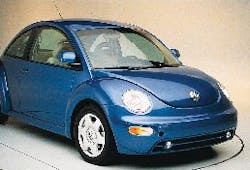Subject: Volkswagon's New Bettle 1998
Topic: Features of the New Beetle
Objective: Understand the Safety Features and Crashworthiness of the New Volkswagon Beetle
Task: List the location of all features of the Beetle that influence rescue and EMS procedures at crash scenes
The Volkswagen Beetle of the 1960s, the famous "Bug" of the flower power generation, is still a common sight on our nation's highways. Many rescuers have responded to VW car fires or crash scenes.
Since its much-publicized introduction in the summer of 1998, responders now are preparing for the inevitable, response to incidents involving the 1998 New Beetle. Because of its completely new design, it is obvious that there are significant differences between the old Bug and the New Beetle. In this article we will look at the New Beetle and explain features of which fire, rescue and EMS personnel should be aware.
The new Beetle is a two-door, uni-body-type sedan with a fully galvanized metal body and plastic, bolt-on front and rear fenders. The 13-foot-long car weighs approximately 2,800 pounds.
The front-wheel-drive New Beetle is powered by a gasoline engine or optional diesel engine mounted under the front hood. The inside hood-release lever is completely hidden from sight. It is a pull-type lever located in the plastic trim material of the A-pillar at almost floor level. The electric switch to release the rear hatchback is positioned on the driver's door. The hatchback lifts up to reveal the back seat and a small trunk storage area.
Volkswagen engineers took an innovative approach to powering electrical components of the New Beetle. The major electrical circuits of the car are connected directly to a fuse block that is itself wired directly to the battery. A plastic battery cover has to be lifted to see the block and all the screw connections. To shut down power, responders should cut or disconnect the black negative cable attached directly to the rear of the battery. Next, the five wires connected to the fuse block on top of the battery should be cut. Finally, to assure total shutdown, the positive hot cable under the wiring block should be cut or disconnected.
The 141?2-gallon fuel tank is located low between the axles of the car, minimizing crash damage in a rear-end collision. The tank is constructed of seamless polypropylene plastic which will react differently than conventional metal tanks during a serious vehicle fire.
Both front doors have a single collision beam, a conventional safety lock and a loop-shaped latch pin assembly. If breaking a door off at the hinges, it will be a challenge to initially get a "purchase" point. The top door hinge is concealed deep inside the front edge of each door. The outside mirror bracket is actually a part of this top door hinge assembly. The bottom hinge is hardly visible when the door is open.
The New Beetle comes equipped with dual front airbags and is one of only a few small size cars with a side impact airbag tucked under the outside edge of each front seat.
There are two warnings to identify the presence of the seat-mounted side-impact airbags. First, an oval-shaped cloth "AIRBAG" label is sewn into the upholstery at the top edge of each front seat. In addition, a factory installed adhesive decal on each B-pillar below the door latch assembly states, "This vehicle is equipped with SIDE-AIRBAG in the seats."
The electronic airbag control module for the dual front bags is mounted on the center tunnel in the front of the passenger compartment. It contains the single crash sensor for the dual front airbags. The side-impact airbags are activated electrically. Individual side-airbag crash sensors are mounted on the floor under the front seats in line with the bottom of the B-pillar. The vehicle's airbag system capacitor has a "drain time" of approximately 10 seconds.
Both driver and passenger front seat belts include mechanically activated crash pretensioner devices to prevent slack from allowing excess forward movement in a crash. Rescuers should unbuckle or cut the seat belts of front seat occupants as soon as possible upon accessing the interior of the car. Avoid cutting the bottom six inches of the B-pillar to prevent cutting into the pretensioner device.
New Beetle crashworthiness testing conducted by the Insurance Institute for Highway Safety, Arlington, VA, involved a 40-mph frontal offset crash test in which slightly less than half of the width of the New Beetle's front end hits a deformable barrier made of aluminum honeycomb.
The offset crash stresses the structure on the front end, particularly the driver's side of the vehicle. In the New Beetle crash, the hood jammed shut and the inside hood release would not open the hood.
The battery in the driver's front corner of the engine compartment was damaged. The electrical terminal connection block and all the cables remained intact. The crash test vehicle's fuel system did not leak.
Institute engineers found that both front doors opened normally after the 40-mph crash. Overall, the survival space surrounding the crash test dummy in the driver's seat was maintained well. Research engineers who studied the forces generated on the crash test dummy's neck, chest and legs report low risk of injury to these body regions.
The New Beetle testing revealed minimal intrusion into the driver footwell area. This has been a consistent problem area with other small vehicles previously tested. There was only minimal rearward movement of the instrument panel during this relatively severe frontal crash.
As a final note, a New Beetle was involved in a July crash in a suburb of Dallas. As the driver, traveling at high speed, lost control of the car and ran off the road, the vehicle barrel rolled as many as 10 times. After the car came to rest, the belted driver released his seat belt, opened the front door and walked away from the crash. Only body damage to the sides and roof, along with a broken rear window told the tale of what could have been a potentially fatal crash.
Ron Moore, a Firehouse? contributing editor, is a battalion chief and the training officer for the McKinney, TX, Fire Department. He also authors a monthly online article in the Firehouse.com ?MembersZone? and serves as the Forum Moderator for the extrication section of the Firehouse.com website. Moore can be contacted directly at [email protected].






